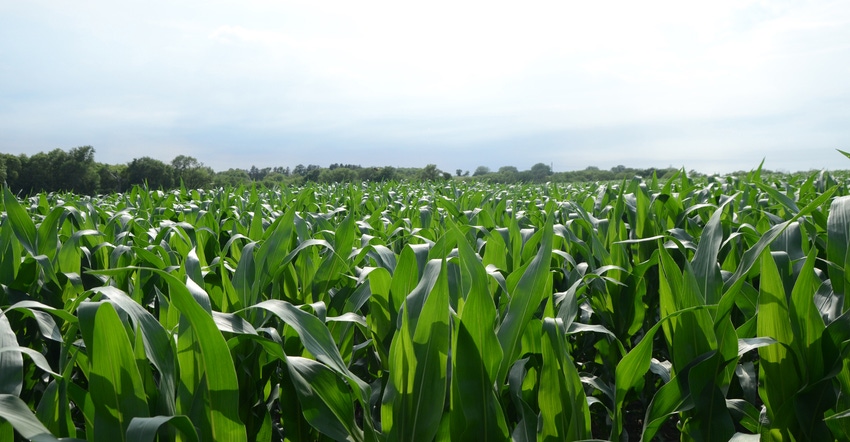
Hybrid and variety selection is one of the biggest decisions leading up to the crop production season. Just how big are these decisions? Matt Stockton, ag economist at the University of Nebraska-Lincoln's West Central Research and Extension Center, recently spoke about the economics of hybrid selection during a virtual water and crops field day.
Stockton says buying the wrong seed could cost more than you think, and he notes a hypothetical comparison between two farms. Both are identical in costs, equipment, fuel usage and land values.
"The only difference is farmer A uses seed that costs $21 [per acre] less than farmer B," he says. "At the end of the season when they harvest the crop, farmer B finds he gets 7 bushels more than farmer A. The question I have is, who makes the most profit? Who did the best? If you can't answer the question, you're not alone. You can't answer the question without more information."
This necessary information includes the difference in cost ($21 per acre) and yield difference (in this case, 7 bushels per acre). However, to answer the question of whether the cost of a hybrid is worth the return, you have to know the value of the bushels.
"If the price was $4 a bushel, that was the value of those bushels, those 7 bushels would be worth $28," Stockton says. "Well, $28 is worth more than $21. So, farmer B would have made a good choice by planting that expensive seed. If it were $3 corn, then neither farmer would've been better off. Both varieties worked just the same.
"If though, prices were less than $3 a bushel … then farmer A, who paid less for the seed, would have gotten a better deal, because farmer B, who spent the extra money on seed, didn't get his return on investment."
Learning from TAPS
Stockton outlined cost to plant per acre in some real-world scenarios from the 2018 Testing Ag Performance Solutions (TAPS) farm management competition at the West Central Research and Extension Center.
The competition involves participants making decisions in six categories throughout the season: hybrid selection, planting population, nitrogen management, irrigation, insurance and marketing.
Stockton compared each of the 20 participants in the 2018 competition based on the different hybrids planted — using hybrid A1 as the baseline variety — at a cost of $94.95 per acre, and B1 through B11 as different hybrids. Seed costs ranged from $71.40 to $129.24 per acre.
However, it isn't just about the cost of seed — it's about the overall difference in profitability based on production expenses, yield and market value for the bushels produced.
TAPS program organizers took data from the A1 hybrid yields and used it to create a statistical model to calculate expected yields from all 20 farms under all conditions — different irrigation and nitrogen conditions — and compared planting the baseline hybrid, A1, with the hybrid the farm used. The value of corn is assumed at $3.20 per bushel, based on its value for the end of the 2018 season.
For example, Farm No. 2 yielded 255.3 bushels per acre using hybrid B1. However, if it used hybrid A1, using the same nitrogen and irrigation rates and planting populations, it would have yielded 288.3 bushels per acre.
Farm No. 5 yielded 246.6 bushels per acre using the B4 hybrid, but would have yielded 273.7 bushels if it planted the A1 hybrid.
Stockton notes most farms would have seen a yield increase by going to the A1 hybrid.
"However, Farm No. 7 had 288.3 bushels," Stockton says. "If he planted our variety, used the same fertilizer and all the other stuff he used on this variety, he would have actually had 6.1 bushels less. Farmer 7 also paid [$23.09 per acre] more for his seed."
It's about profitability
How does this equate to return on investment? Stockton also compared the return on investment based on an assumed $3.20 per bushel value of corn.
"The one with the most gain was Farm 8, where he would have paid $7 less [by using hybrid A1] than he would have for the seed that he bought. He would have made $166.58 more corn if he had planted the variety [A1]. That's quite a difference," says Stockton, noting that was the most extreme case, with a difference of $173.58 per acre in return on investment, just by using a different hybrid.
"Farm 7 is kind of interesting, because we have $23.09 for cost savings; that's how much he would save from the cost of seed, but he would have lost $19.63 in revenue because there was less corn produced," he adds. "It's close; it's only a $3.46 difference. That means he only made $3.46 less than he would had he changed his variety."
The question to ask is, how do growers make their hybrid selection decisions?
"It makes a giant difference in profitability from what's produced," Stockton says. "We need to find ways to figure out exactly what that corn's going to do in your field, so you can select the right variety based on its price and the value of corn. That way, you know you've maximized your profitability. That's just one way precision management can help you on your farm in your farm decisions."
About the Author(s)
You May Also Like






